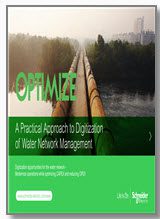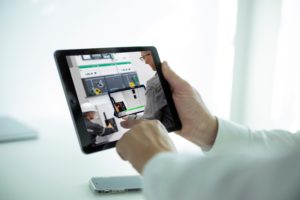Like most businesses this year, the water industry has had to adjust their working methods while maintaining water quality and efficient operations. Water, like many other industries has realized that the need to keep operational and maintenance workers safe by maintaining social distancing protocols presents them with a unique set of difficulties.
With the many challenges the industry already faces, like water scarcity, rising demand and aging infrastructures, this year has continued to shine the light on the urgent need to digitize water operations. Digitization enables remote access to water networks which may be spread out over many kilometres. The good news is that once data is flowing it can be harnessed to provide remote access (by network staff and experts) and to improve maintenance and operating efficiency. Many of us are working remotely today for safety reasons and connect to our organizations digitally, but what about operations and maintenance workers? Digitizing water systems can allow operational and maintenance staff to keep tabs on things while maintaining social distance – or in some cases even having to go onsite.
The operational lifecycle of a typical municipal water network extends over many decades, and over that time the efficiency with which you operate, or lack of it, can add up to millions of dollars.
Pump performance for example can positively or negatively impact many things, including energy use, pump wear and tear, downtime and maintenance cost. Demand for water across the network at any time of day is continuously changing and we know that (for any given pressure and flow) pumps perform most reliably and efficiently when they are running at one particular speed. To be ready for hourly demand changes many large pumps are set to run at higher operating points, building in safety margins. This practice can waste electrical energy and shorten the life of the pump. So again, once data is flowing it can be used to set pumps to more closely match demand, use less energy, and run more reliably to maintain water quality.
Water networks, with poorly controlled and unbalanced pressures, can cause water leakage and loss of revenue. On the other hand, if these networks are fully integrated and optimized, operators can greatly reduce OpEx by saving significant energy, treatment and maintenance costs. Since many water networks consist of older pipes buried under roads and buildings, leaks are hard to find and even more costly and difficult to repair. Protecting these older networks from pressure spikes which could cause water leakage makes perfect sense on a number of different levels.
Riding the digitization wave
Taking the first step towards digital transformation can seem daunting but we’ve helped many water operators across the world to optimize their operations. We continue to invest in and build our portfolio of solutions to address more and more applications including an Integrated Water Network Management Solution – A complete control and supervisory system which natively connects the different layers of water network applications from software, to control, to field devices. Linking control and supervisory systems together when water networks are first automated means they’re linked for their entire lifetime. This reduces initial engineering design time and cost and, once systems are operating the approach makes it easier and less costly to accurately optimize them.
Early adopters of the digital transformation have shown savings up to 30% in energy consumption. Water treatment plants and water distribution networks can increase operational efficiency by up to 25%, and total cost of ownership (TCO) can be reduced up to 20% when comparing digitized assets to traditional assets.
For those water and wastewater operators ready to investigate and embrace digitization as a means to improve operational efficiency, several short-term and long-term steps can be taken:
- Within the next month – Identify initial areas where engineering and operational costs are high and where project delivery times could potentially be reduced.
- Within the next 6 months – Explore funding options and begin to assemble a cross functional team of interested internal stakeholders.
- Within the next year – Implement at least one new digital platform solution pilot. Track expenses and quantify benefits during this pilot.
Many industries realized that implementing their own digital transformation could bring greater visibility into their operations and operate at higher levels of operational efficiency before the unique challenges of 2020 came along. Today’s research confirms that companies who were among the first to embrace digitization were the ones most able to flexibly pivot and adapt most effectively to the new normal. Customers have told us that this year has continued to shine the light on the urgent need to digitize their operations. Digitizing with the right Integrated Water Network Management system could offer fast, cost effective access to the data needed to safely operate water networks at higher levels of efficiency and lower levels of OpEx than ever before.
 Discover more in our dedicated Integrated Water Network Management eGuide.
Discover more in our dedicated Integrated Water Network Management eGuide.



